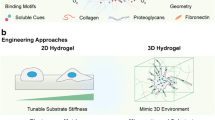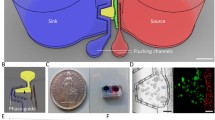Abstract
Purpose of Review
Stem cells are exquisitely sensitive to biophysical and biochemical cues within the native microenvironment. This review focuses on emerging strategies to manipulate neural cell behavior using these influences in three-dimensional (3D) culture systems.
Recent Findings
Traditional systems for neural cell differentiation typically produce heterogeneous populations with limited diversity rather than the complex, organized tissue structures observed in vivo. Advancements in developing engineering tools to direct neural cell fates can enable new applications in basic research, disease modeling, and regenerative medicine.
Summary
This review article highlights engineering strategies that facilitate controlled presentation of biophysical and biochemical cues to guide differentiation and impart desired phenotypes on neural cell populations. Specific highlighted examples include engineered biomaterials and microfluidic platforms for spatiotemporal control over the presentation of morphogen gradients.


Similar content being viewed by others
References
Papers of particular interest, published recently, have been highlighted as: • Of importance •• Of major importance
Deleyrolle LP, Reynolds BA. Isolation, expansion, and differentiation of adult mammalian neural stem and progenitor cells using the neurosphere assay. Methods Mol Biol. 549:91–101. https://doi.org/10.1007/978-1-60,327-931-4_7.
Román-Trufero M, Méndez-Gómez HR, Pérez C, et al. Maintenance of undifferentiated state and self-renewal of embryonic neural stem cells by polycomb protein Ring1B. Stem Cells. 27:1559–70. https://doi.org/10.1002/stem.82.
Moon SY, Bin PY, Kim DS. et al, Generation, culture, and differentiation of human embryonic stem cells for therapeutic applications. Mol Ther. 13:5–14. https://doi.org/10.1016/j.ymthe.2005.09.008.
Seidlits SK, Khaing ZZ, Petersen RR, et al. The effects of hyaluronic acid hydrogels with tunable mechanical properties on neural progenitor cell differentiation. Biomaterials. 31:3930–40. https://doi.org/10.1016/j.biomaterials.2010.01.125.
Lantoine J, Grevesse T, Villers A, et al. Matrix stiffness modulates formation and activity of neuronal networks of controlled architectures. Biomaterials. 89:14–24. https://doi.org/10.1016/j.biomaterials.2016.02.041.
Wei YT, Tian WM, Yu X, et al. Hyaluronic acid hydrogels with IKVAV peptides for tissue repair and axonal regeneration in an injured rat brain. Biomed Mater. 2. https://doi.org/10.1088/1748-6041/2/3/S11.
Lewitt MS, Boyd GW. The role of insulin-like growth factors and insulin-like growth factor–binding proteins in the nervous system. Biochem Insights. 12:117862641984217. https://doi.org/10.1177/1178626419842176.
Panchision DM, McKay RDG. The control of neural stem cells by morphogenic signals. Curr Opin Genet Dev. 12:478–87. https://doi.org/10.1016/S0959-437X(02)00329-5.
Nusse R, Fuerer C, Ching W, et al. Wnt signaling and stem cell control. Cold Spring Harb Symp Quant Biol. 73:59–66. https://doi.org/10.1101/sqb.2008.73.035.
Monneau Y, Arenzana-Seisdedos F, Lortat-Jacob H. The sweet spot: how GAGs help chemokines guide migrating cells. J Leukoc Biol. 99:935–53. https://doi.org/10.1189/jlb.3mr0915-440r.
Proudfoot AEI, Johnson Z, Bonvin P, Handel TM. Glycosaminoglycan interactions with chemokines add complexity to a complex system. Pharmaceuticals. 10:70. https://doi.org/10.3390/ph10030070.
Nikolopoulou E, Galea GL, Rolo A, et al. Neural tube closure: cellular, molecular and biomechanical mechanisms. Development. 144:552–66. https://doi.org/10.1242/dev.145904.
Long KR, Huttner WB. How the extracellular matrix shapes neural development. Open Biol. 9. https://doi.org/10.1098/rsob.180216.
Thion MS, Ginhoux F, Garel S. Microglia and early brain development: an intimate journey. Science. 362(80):185–9. https://doi.org/10.1126/science.aat0474.
Arcuri C, Mecca C, Bianchi R, et al. The pathophysiological role of microglia in dynamic surveillance, phagocytosis and structural remodeling of the developing CNS. Front Mol Neurosci. 10. https://doi.org/10.3389/fnmol.2017.00191.
Fan Y, Xie L, Chung CY. Signaling pathways controlling microglia chemotaxis. Mol Cells. 40:163–8. https://doi.org/10.14348/molcells.2017.0011.
Moshayedi P, Ng G, Kwok JCF, et al. The relationship between glial cell mechanosensitivity and foreign body reactions in the central nervous system. Biomaterials. 35:3919–25. https://doi.org/10.1016/j.biomaterials.2014.01.038.
Segel M, Neumann B, Hill MFE, et al. Niche stiffness underlies the aging of central nervous system progenitor cells. Nature. 573:130–4.
Keung AJ, Dong M, Schaffer DV, Kumar S. Pan-neuronal maturation but not neuronal subtype differentiation of adult neural stem cells is mechanosensitive. Sci Rep. 3. https://doi.org/10.1038/srep01817.
Leipzig ND, Shoichet MS. The effect of substrate stiffness on adult neural stem cell behavior. Biomaterials. 30:6867–78. https://doi.org/10.1016/j.biomaterials.2009.09.002.
Saha K, Keung AJ, Irwin EF, et al. Substrate modulus directs neural stem cell behavior. Biophys J. 95:4426–38. https://doi.org/10.1529/biophysj.108.132217.
Keung AJ, Asuri P, Kumar S, Schaffer DV. Soft microenvironments promote the early neurogenic differentiation but not self-renewal of human pluripotent stem cells. Integr Biol (United Kingdom). 4:1049–58. https://doi.org/10.1039/c2ib20083j.
Musah S, Wrighton PJ, Zaltsman Y, et al. Substratum-induced differentiation of human pluripotent stem cells reveals the coactivator YAP is a potent regulator of neuronal specification. Proc Natl Acad Sci U S A. 111:13805–10. https://doi.org/10.1073/pnas.1415330111.
Spearman BS, Agrawal NK, Rubiano A, et al. Tunable methacrylated hyaluronic acid-based hydrogels as scaffolds for soft tissue engineering applications. J Biomed Mater Res - Part A. 108:279–91. https://doi.org/10.1002/jbm.a.36814.
Yue K, Trujillo-de Santiago G, Alvarez MM, et al. Synthesis, properties, and biomedical applications of gelatin methacryloyl (GelMA) hydrogels. Biomaterials. 73:254–71. https://doi.org/10.1016/j.biomaterials.2015.08.045.
Sun M, Sun X, Wang Z, et al. Synthesis and properties of gelatin methacryloyl (GelMA) hydrogels and their recent applications in load-bearing tissue. Polymers (Basel). 10. https://doi.org/10.3390/POLYM10111290.
• Ondeck MG, Engler AJ. Mechanical characterization of a dynamic and tunable methacrylated hyaluronic acid hydrogel. J Biomech Eng. 138. https://doi.org/10.1115/1.4032429(The above referenced the modification of methacrylated hyaluronic acid to create a dynamic and tunable hydrogel for studying cellular responses to hydrogel stiffening).
• Zhou X, Cui H, Nowicki M, et al. ACS Appl Mater Interfaces. 10:8993–9001. https://doi.org/10.1021/acsami.7b18197(The referenced article describes how dopamine conjugated to the backbone of GelMA enhances neural cell survival and differentiation).
Wu S, Xu R, Duan B, Jiang P. Three-dimensional hyaluronic acid hydrogel-based models for in vitro human iPSC-derived NPC culture and differentiation. J Mater Chem B. 5:3870–8. https://doi.org/10.1039/c7tb00721c.
Zhang ZN, Freitas BC, Qian H, et al. Layered hydrogels accelerate iPSC-derived neuronal maturation and reveal migration defects caused by MeCP2 dysfunction. Proc Natl Acad Sci U S A. 113:3185–90. https://doi.org/10.1073/pnas.1521255113.
Qi L, Li N, Huang R, et al. The effects of topographical patterns and sizes on neural stem cell behavior. PLoS One. https://doi.org/10.1371/journal.pone.0059022.
Chen W, Han S, Qian W, et al. Nanotopography regulates motor neuron differentiation of human pluripotent stem cells. Nanoscale. 10:3556–65. https://doi.org/10.1039/c7nr05430k.
Xie J, MacEwan MR, Schwartz AG, Xia Y. Electrospun nanofibers for neural tissue engineering. Nanoscale. 2:35–44. https://doi.org/10.1039/b9nr00243j.
Cao H, Liu T, Chew SY. The application of nanofibrous scaffolds in neural tissue engineering. Adv Drug Deliv Rev. 61:1055–64. https://doi.org/10.1016/j.addr.2009.07.009.
Seidlits SK, Lee JY, Schmidt CE. Nanostructured scaffolds for neural applications. Nanomedicine. 3:183–99. https://doi.org/10.2217/17435889.3.2.183.
Nichol JW, Koshy ST, Bae H, et al. Cell-laden microengineered gelatin methacrylate hydrogels. Biomaterials. 31:5536–44. https://doi.org/10.1016/j.biomaterials.2010.03.064.
Rao SS, Winter JO. Adhesion molecule-modified biomaterials for neural tissue engineering. Front Neuroeng. 2. https://doi.org/10.3389/neuro.16.006.2009.
Hersel U, Dahmen C, Kessler H. RGD modified polymers: biomaterials for stimulated cell adhesion and beyond. Biomaterials. 24:4385–415. https://doi.org/10.1016/S0142-9612(03)00343-0.
Lampe KJ, Antaris AL, Heilshorn SC. Design of three-dimensional engineered protein hydrogels for tailored control of neurite growth. Acta Biomater. 9:5590–9. https://doi.org/10.1016/j.actbio.2012.10.033.
Madl CM, Lesavage BL, Dewi RE, et al. Maintenance of neural progenitor cell stemness in 3D hydrogels requires matrix remodeling. Nat Mater. 16:1233–42. https://doi.org/10.1038/nmat5020.
Madl CM, LeSavage BL, Dewi RE, et al. Matrix remodeling enhances the differentiation capacity of neural progenitor cells in 3D hydrogels. Adv Sci. 6. https://doi.org/10.1002/advs.201801716.
Ranga A, Girgin M, Meinhardt A, et al. Neural tube morphogenesis in synthetic 3D microenvironments. Proc Natl Acad Sci U S A. 113:E6831–9. https://doi.org/10.1073/pnas.1603529113.
Madl CM, Heilshorn SC. Engineering hydrogel microenvironments to recapitulate the stem cell niche. Annu Rev Biomed Eng. 20:21–47. https://doi.org/10.1146/annurev-bioeng-062117-120954.
Schneider MD. Upstairs, downstairs: atrial and ventricular cardiac myocytes from human pluripotent stem cells. Cell Stem Cell. 21:151–2. https://doi.org/10.1016/j.stem.2017.07.006.
Barker N. Adult intestinal stem cells: critical drivers of epithelial homeostasis and regeneration. Nat Rev Mol Cell Biol. 15:19–33. https://doi.org/10.1038/nrm3721.
Schilling TF. Anterior-posterior patterning and segmentation of the vertebrate head. Integr Comp Biol. 48:658–67.
Roelink H, Porter JA, Chiang C, et al. Floor plate and motor neuron induction by different concentrations of the amino-terminal cleavage product of sonic hedgehog autoproteolysis. Cell. 81:445–55.
Ribes V, Briscoe J. Establishing and interpreting graded Sonic Hedgehog signaling during vertebrate neural tube patterning: the role of negative feedback. Cold Spring Harb Perspect Biol. 1.
Tao Y, Zhang SC. Neural Subtype Specification from Human Pluripotent Stem Cells. Cell Stem Cell. 19:573–86.
Lippmann ES, Williams CE, Ruhl DA, et al. Deterministic HOX patterning in human pluripotent stem cell-derived neuroectoderm. Stem Cell Reports. 4:632–44. https://doi.org/10.1016/j.stemcr.2015.02.018.
Silva TP, Cotovio JP, Bekman E, et al. Design principles for pluripotent stem cell-derived organoid engineering. Stem Cells Int. 2019. https://doi.org/10.1155/2019/4508470.
•• Cosson S, Lutolf MP. Hydrogel microfluidics for the patterning of pluripotent stem cells. Sci Rep. 4:1–6. https://doi.org/10.1038/srep04462. This report created a microfluidic system that allowed precise spatiotemporal delivery of biomolecules.
•• Demers CJ, Soundararajan P, Chennampally P, et al. Development-on-chip: in vitro neural tube patterning with a microfluidic device. Development. 143:1884–92. https://doi.org/10.1242/dev.126847. The referenced article provides a versitly microfluidic platform for simultanious opposing and/or orthagonal grandients of morphogens.
Uzel SGM, Amadi OC, Pearl TM, et al. Simultaneous or sequential orthogonal gradient formation in a 3D cell culture microfluidic platform. Small. 12:612–22. https://doi.org/10.1002/smll.201501905.
Regier MC, Tokar JJ, Warrick JW, et al. User-defined morphogen patterning for directing human cell fate stratification. Sci Rep. 9. https://doi.org/10.1038/s41598-019-42874-8.
Manfrin A, Tabata Y, Paquet ER, et al., Engineered signaling centers for the spatially controlled patterning of human pluripotent stem cells. Nat Methods 16:640–648. Doi:https://doi.org/10.1038/s41592-019-0455-2.
Petrik D, Myoga MH, Grade S, et al. Epithelial sodium channel regulates adult neural stem cell proliferation in a flow-dependent manner. Cell Stem Cell. 22:865–878.e8. https://doi.org/10.1016/j.stem.2018.04.016.
O’Grady BJ, Balikov DA, Lippmann ES, Bellan LM. Spatiotemporal control of morphogen delivery to pattern stem cell differentiation in three-dimensional hydrogels. Curr Protoc Stem Cell Biol. 51. https://doi.org/10.1002/cpsc.97.
O’Grady B, Balikov DA, Wang JX, et al. Spatiotemporal control and modeling of morphogen delivery to induce gradient patterning of stem cell differentiation using fluidic channels. Biomater Sci. 7:1358–71. https://doi.org/10.1039/c8bm01199k.
Funding
Work in our laboratory related to this review is supported by funding from the Chan Zuckerberg Initiative (grant 2018-191850 to ESL) and the National Science Foundation (grant 1706155 to ESL). BJO is supported by the Interdisciplinary Training Program in Alzheimer’s Disease funded by the National Institutes of Health (T32 AG058524).
Author information
Authors and Affiliations
Corresponding author
Ethics declarations
Conflict of Interest
Dr. O’Grady and Dr. Lippmann have nothing to disclose.
Additional information
This article is part of the Topical Collection on Cell Behavior Manipulation
Rights and permissions
About this article
Cite this article
O’Grady, B.J., Lippmann, E.S. Recent Advancements in Engineering Strategies for Manipulating Neural Stem Cell Behavior. Curr. Tissue Microenviron. Rep. 1, 41–47 (2020). https://doi.org/10.1007/s43152-020-00003-y
Published:
Issue Date:
DOI: https://doi.org/10.1007/s43152-020-00003-y




